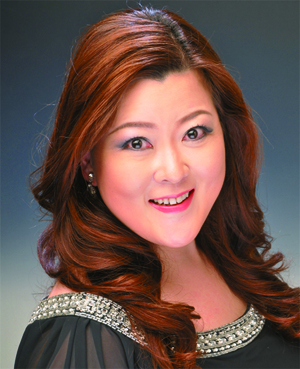
Shoko Fukuda
Chair, Nihonbashi Opera Tokyo
Greetings
Thank you very much for coming to see Nihonbashi Opera 2021 Premier "Madame Chrysanthème (Okiku-san)". I would like to celebrate with you for its first performance in Japan, which has been postponed due to the Corona virus pandemic.
This opera is based on history. The author, Pierre Loti, visited Nagasaki in 1885 as an officer of the French Navy. His short marriage with Okane-san in Nagasaki inspired him to write a novel "Madame Chrysanthème", which became a best-selling novel in Europe. Then, André Messager composed music for the novel. It was first performed in Paris in 1893. The three figures on the cover photo of this brochure are Okane-san, Pierre, and Yves. The photo was taken at Hikoma Ueno's photography studio in Nagasaki. Loti became a famous writer in the world. And his footprints can still be seen in Nagasaki today. But Okane-san's life has been unknown except she remarried with a lantern shop owner. Our recent research found Okane-san's childhood life and life after meeting Loti. We also found relationship between Messager and Puccini. These findings were pleasant surprises to us and reminded us for the profoundness of this opera. We hope today's performance may trigger further research to rewrite music and world history. In short, "Madame Chrysanthème" is a treasure mountain that can be connected to each one of us!
We encountered the opera "Madame Chrysanthème" three years ago when we were making a program for the next performance of Mascagni's "Iris". We found the existence of "Madame Chrysanthème", downloaded a free music score on the Internet, and immediately started singing it. The music score was 130-year-old and had some blurred spots. But we were astonished by the ensemble of Buddhism chant "Nam Admida Butsu" with spectacular, late-19th century French music. Its music even goes beyond contemporary operreta, and thus requires high level of diversity to play the music. We felt it was our duty to play this opera as it was a forgotten opera based in Japan. We took one year to translate it to Japanese, corrected some mistakes on the music, and created the music score we perform today. The biggest attractiveness of this opera is how lively the Japanese characters are depicted. It depicts the Japanese in the Meiji era. Loti actually despised them. But it portrays how people enjoyed their life with wisdom and broad-mind. In this performance, we invite Noh Master of Konparu Style, Mr. Tsunao Yamai, who is going to perform Noh in this opera. We expect something interesting can happen in collaboration of traditional arts in the East and West.
I hope you enjoy our performance
This opera is based on history. The author, Pierre Loti, visited Nagasaki in 1885 as an officer of the French Navy. His short marriage with Okane-san in Nagasaki inspired him to write a novel "Madame Chrysanthème", which became a best-selling novel in Europe. Then, André Messager composed music for the novel. It was first performed in Paris in 1893. The three figures on the cover photo of this brochure are Okane-san, Pierre, and Yves. The photo was taken at Hikoma Ueno's photography studio in Nagasaki. Loti became a famous writer in the world. And his footprints can still be seen in Nagasaki today. But Okane-san's life has been unknown except she remarried with a lantern shop owner. Our recent research found Okane-san's childhood life and life after meeting Loti. We also found relationship between Messager and Puccini. These findings were pleasant surprises to us and reminded us for the profoundness of this opera. We hope today's performance may trigger further research to rewrite music and world history. In short, "Madame Chrysanthème" is a treasure mountain that can be connected to each one of us!
We encountered the opera "Madame Chrysanthème" three years ago when we were making a program for the next performance of Mascagni's "Iris". We found the existence of "Madame Chrysanthème", downloaded a free music score on the Internet, and immediately started singing it. The music score was 130-year-old and had some blurred spots. But we were astonished by the ensemble of Buddhism chant "Nam Admida Butsu" with spectacular, late-19th century French music. Its music even goes beyond contemporary operreta, and thus requires high level of diversity to play the music. We felt it was our duty to play this opera as it was a forgotten opera based in Japan. We took one year to translate it to Japanese, corrected some mistakes on the music, and created the music score we perform today. The biggest attractiveness of this opera is how lively the Japanese characters are depicted. It depicts the Japanese in the Meiji era. Loti actually despised them. But it portrays how people enjoyed their life with wisdom and broad-mind. In this performance, we invite Noh Master of Konparu Style, Mr. Tsunao Yamai, who is going to perform Noh in this opera. We expect something interesting can happen in collaboration of traditional arts in the East and West.
I hope you enjoy our performance